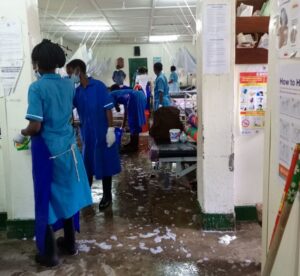Monitoring hand hygiene progress in Uganda health facilities to curb infections
Hassan Kasujja and JP Waswa
Hand hygiene (HH) is the key strategy for infection prevention and control (IPC) and one of the most effective interventions for prevention of hospital care-associated infections (HAIs). Despite the overwhelming evidence of how HH improves patient safety, its implementation, especially in low- and middle-income countries (LMICs), remains poor because of unique barriers, including overcrowding in health facilities, inadequate HH infrastructure, and lack of sustainable supply of HH products, including alcohol-based handrub (ABHR). To ensure adherence to HH practices, WHO recommends that health facilities monitor compliance to HH. Although efforts are ongoing to build capacity for HH monitoring, implementation remains a challenge. We highlight some of the experiences, successes, and challenges with HH monitoring in the context of LMICs.
The USAID MTaPS program has supported health facilities in establishing and improving HH programs in Uganda, in line with the guide to the Implementation of the WHO Multimodal Hand Hygiene Improvement Strategy.

Weekly general cleaning of the medical ward, Kagando Hospital. Photo Credit: JP Waswa/MTaPS Uganda
The approach included training hospital staff on HH practices and baseline assessments using WHO HH assessment tools including:
• Hygiene Self-Assessment Framework (HHSAF) for assessing the capacity of health facilities to implement HH programs
• HH observation tool designed to monitor compliance in various health settings
• knowledge questionnaire on HH
• survey on the perceptions of health care workers (HCWs) on HH
• survey on the perceptions of health care workers (HCWs)of senior managers on HH
• the ward infrastructure survey
• tool to assess soap and alcohol-based hand rub consumption in facilities
Health facilities were supported to use the findings to draft continuous quality improvement (CQI) plans focused on improving HH compliance. CQI approaches, including application of the plan-do-study-act cycle with repeated assessments of HH compliance and taking corrective action, were implemented.
Challenges in Monitoring HH
• There is inadequate capacity at both the national and health facility levels to implement HH programs and monitor compliance in the health facilities. The country has not adopted and implemented the WHO multimodal strategies for HH improvement, making capacity building for HH a challenge as it is not part of the national strategy.
• Currently, the health information management systems in the country do not capture data on HH, leaving the implementation of HH compliance monitoring to health facilities and implementing partners.
• Application of the HH compliance tool is labor-intensive, and, given the human resources for health (HRH) challenges in most health facilities in Uganda, this presents a major barrier to implementation of the tool.
• Last, there is inadequate capacity for data management at the health facility level, with lack of computers and statisticians to do basic analysis of the data generated from the surveys.
Lessons Learned and Recommendations
HH compliance monitoring cannot be implemented in isolation: Improving HH and advancing the culture of HH monitoring will require national efforts to prioritize HH and implement the relevant tools. This will support the development of a critical technical mass of HRH skilled in HH and provide resources that could be used for HH monitoring.
Being a behavioral change activity, HH improvement is a gradual process: Improvement will be gradual. Indicators are needed at the start of a program to evaluate the results over time.
WHO needs to support ministries of health to adopt these tools for country context: Some of the tools remain complex for lower-level facilities facing HRH shortages.
Prioritize capacity building for HH monitoring to ensure efficiency and sustainability: There is need to emphasize the end result of monitoring HH, i.e. reducing HCAIs and improving patient safety to ensure ownership by health workers. Without emphasizing this and developing systems for HCAI surveillance, data on HH may be viewed by health workers as ‘’just’’ another survey by the ministry of health and partners.
Strengthen capacity for HCAI surveillance: Evaluation and assessment of HH should be followed by instant feedback to ensure that concerns are addressed timeously for program result improvement. This should be instantaneous to address concerns that would drag the program. Additionally, it is important to interpret HH compliance findings alongside findings from other surveys when discussing them with health workers to ensure a holistic view of the issues.
Conclusion
Compliance monitoring is critical to setting up HH programs. However, compliance monitoring cannot be done in isolation of other inputs into HH programs, for example, the WHO multimodal strategies. It is equally important to consider outcomes of monitoring HH when developing capacity for compliance, i.e., HH compliance should be linked to HCAI surveillance programs. Without linking compliance to key national indicators, progress of HH programs and compliance monitoring at health facilities will remain a challenge.